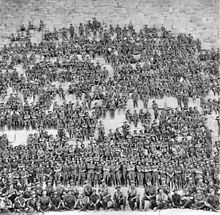Battalion
![]()
The title of this article is ambiguous. For the French novelist of the same name, see Marcel Bataillon.
A battalion (IPA: [batalˈjoːn] or [bataˈjoːn], also: [bataˈjɔ̃ː], ![]() ; from French bataillon; variant English battalion) is a military unit in which several companies or batteries of a troop type are combined to form an organically composed force of 300 to 1200 soldiers. These can be equipped with partly different, complementary equipment. A battalion may contain soldiers of other uses such as a staff and supply company with medics, repairmen, and/or staff service soldiers.
; from French bataillon; variant English battalion) is a military unit in which several companies or batteries of a troop type are combined to form an organically composed force of 300 to 1200 soldiers. These can be equipped with partly different, complementary equipment. A battalion may contain soldiers of other uses such as a staff and supply company with medics, repairmen, and/or staff service soldiers.
A battalion is led by a battalion commander, usually in the rank of lieutenant colonel, more rarely a major. In contrast to the next lower form of organization, the company, the battalion has its own staff and usually a staff and possibly support companies. The next larger military unit is the regiment; today, however, the battalion is usually directly subordinate to a brigade as the next higher large unit.

Military symbol of the Austrian Tank Battalion 14 according to NATO standard. The two vertical lines on the rectangular frame indicate that it is a battalion.

Group picture of an Australian infantry battalion from the First World War
Historical development
The word "battalion" comes from the French word bataille (battle, order of battle); bataillon therefore means a troop formed for battle. In the 15th and 16th centuries, this word was used to describe any independent battle group of foot soldiers, regardless of their strength, which appeared in the form of a quadrilateral and was therefore also called Gevierthaufen or Gewalthaufen in German-speaking forces, armies or armies. A single infantry company formed in battle order was called a "battalion" just as much as a regiment formed for battle. The term served only to designate a formation for battle.
With the Huguenots, the term also came to Germany in the 17th century. In the course of the at that time stronger subdivision of the order of battle to smaller formations of the foot troops with fixed sizes (cf. Ordonnance (Gefechtsordnung)) the new term was introduced for these instead of the older Schlachthaufen. The final uniform introduction of the term for fixed subdivisions of infantry regiments, each comprising several companies, occurred in France in 1635, in Prussia in 1686, and in Austria in 1695.
The introduction of the flintlock rifle with bayonet increased the importance of the battalion, so that at the beginning of the 18th century it became the basic tactical body of the infantry fighting according to linear tactics. In the 18th century, so-called free battalions were also established in Prussia, which were not assigned to any regiment, but represented independent administrative units (mainly hunter battalions).
In the 17th century, the battalion in the various countries consisted of 4 to 17 companies with 500 to 1000 men. The Prussian battalion of 1000 men in 4 to 5 companies became the model for other armies in the 18th century. It was a tactical formation, divided into two wings of two divisions of two pelotons each for combat. Light artillery (battalion guns) could be added. Inspired by Napoleon's successes with column tactics, the battalion column became established throughout Europe from 1815 onwards. The military successes of Prussia in the second half of the 19th century made the Prussian battalion of that time, with 4 companies of three platoons each and with a war strength of 26 officers and 1054 non-commissioned officers and men (1914), the trend-setting model.
In World War I, the strength of the German Army's infantry battalions dropped to 650 men, divided into four companies plus a machine-gun detachment, due to increased firepower as well as a shortage of personnel. In the Reichswehr and Wehrmacht, the infantry battalion was not significantly reorganized and by the early years of World War II numbered just over 800 men including 23 officers in three companies and one machine gun company (plus battalion staff and intelligence squadron) (as of May 1941).

Battalion of an Imperial Regiment to Montecuccoli
Independent battalion
In the second half of the 19th century, more and more independent battalions were formed from special troops that were not assigned to a regiment but were directly subordinate to divisions or corps. First and foremost among these were the pioneers, the train, airmen, telegraphs and the like. For these, as well as for the artillery, the term Abteilung was sometimes used.
The National People's Army designated the independent battalion (B for short) as a general tactical unit.
Search within the encyclopedia